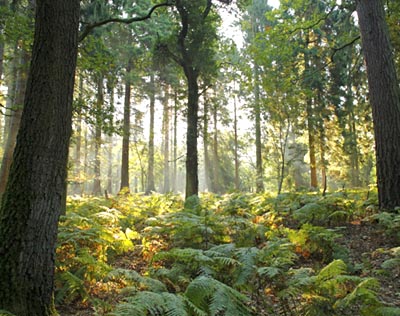Forests report backs public ownership
Our forests should remain in public ownership, and be administered by a new body answerable to Parliament, says the Independent Panel on Forestry


The Independent Panel on Forestry, which was asked by the Government to find a consensus on the future of England's forests following the ‘sell-off' furore last year, is backing a continuing role for the public forest estate. The panel recommends it be administered by a new body, evolved out of the current Forest Enterprise England, which is answerable to Parliament. It would have the freedom to be entrepreneurial, raise capital and take long-term decisions independent of short-term funding issues. ‘For England's national woodlands to flourish,' the report observes pointedly, ‘policy and investment decisions need to be linked to woodland, rather than electoral, cycles.'
The report received praise-for different reasons-from most stake-holders, including the RSPB, Countryside Alliance and the GWCT, which points out that woodland managed for shooting is often rich in biodiversity, as well as the Forestry Commission itself. CLA president Harry Cotterell says: ‘The report recognises that private woodland ownership still has a major part to play, and this is despite the sector being in the economic doldrums for 20 years. Proper forestry policy should lead to a renaissance. Timber is the greenest material for construction, woodfuel is among the most environmentally friendly sources of energy, and woodland provides immense benefits for the environment.'
The National Trust's natural environment director Simon Pryor says the panel has ‘got it right' in saying the public forest estate should be ‘held in trust for the nation' and encourages the Government to implement the report. ‘If it does, the nation's protest last year will not only have saved the public forest estate, it will have triggered a step change in the way we treat woodland in England.'

The report says the annual cost of running the public forests is £20 million-90p per year per household but that the return in benefits to people, nature and the economy is more like £400 million. Prof Mark Shucksmith of Newcastle University comments: ‘Successive studies have shown that the public benefits of access, biodiversity and mitigating climate change are substantially greater than the value of the timber produced. These benefits would be placed at risk if the forests were passed in to private hands. Sustained government support, in terms of finance and know-how, is clearly justified.'
The report is remarkable for the breadth of its recommendations, stepping far beyond the rather one-track debate about public access and ownership that dominated the original controversy. The RSPB's Mike Clarke, a panel member, says the report has ‘filled a vacuum in the national discussions on forestry, taking the debate out of its traditional "box" and examining it in terms of its wider relationship to society'. Pointing out that 82% of our woods lie outside the public-forest estate anyway, the report urges the creation of a ‘new woodland culture in which woodlands and wood as a material and fuel are highly valued and sought after'.
It urges the Government to be pro-active in pioneering a new approach to valuing and rewarding the management of woodland ecosystems for all the benefits they provide. Investment in businesses such as sawmills, furniture and creative industries through organisations such as local Enterprise Partnerships could create 7,000 jobs. Wood-based industries and tech-nologies should be a priority area for the Green Investment Bank, which will have £3 million of capital to support the Green economy. Local authorities should integrate tree and woodland strategies into plans and introduce a ‘Wood First' policy to increase the use of wood in construction projects.
Jude Walker, executive director of the charity Small Woods, applauds the proposal to provide advice to wood-land owners on the benefits of multi-purpose forestry. ‘This should include woodlands under five hectares [12 acres] as well, as owners of smaller woodlands are often those who need the advice most.' She also welcomes the call to increase woodland cover from 10% to 15% of England by 2060 in contrast, the EU average is 37% via new planting.
Sign up for the Country Life Newsletter
Exquisite houses, the beauty of Nature, and how to get the most from your life, straight to your inbox.
Plantlife's Andy Byfield concurs, but adds a cautionary note: ‘We don't want a mindless approach to tree-planting anywhere. Experience tells us little coppices are difficult to manage for economic pur-poses. There is also the danger that if trees are planted in inappropriate areas, they could destroy semi-natural open habitats. It's important to remember, for instance, that 80% of the 250 or so woodland specialist plants are actually species of open spaces. The ideal forest landscape is one of mixed habitats, encompassing heathland and wood pasture as well as high forest.'
The panel echoed early green-space campaigners such as National Trust co-founder Octavia Hill in calling for the Government to increase significantly the amount of woods accessible to people in urban areas, and for local authorities to ensure every child has an element of woodland-based learning in their education. Dr Tony Whitbread, head of the Sussex Wildlife Trust, adds: ‘The report is the crucial first step in engendering an understanding of the true value of woodlands.' Jack Watkins
* Subscribe to Country Life and Pay just £29.99
Country Life is unlike any other magazine: the only glossy weekly on the newsstand and the only magazine that has been guest-edited by HRH The King not once, but twice. It is a celebration of modern rural life and all its diverse joys and pleasures — that was first published in Queen Victoria's Diamond Jubilee year. Our eclectic mixture of witty and informative content — from the most up-to-date property news and commentary and a coveted glimpse inside some of the UK's best houses and gardens, to gardening, the arts and interior design, written by experts in their field — still cannot be found in print or online, anywhere else.
-
 'The watch is Head Boy of men’s accessorising': Ginnie Chadwyck-Healey and Tom Chamberlin's Summer Season style secrets
'The watch is Head Boy of men’s accessorising': Ginnie Chadwyck-Healey and Tom Chamberlin's Summer Season style secretsWhen it comes to dressing for the Season, accessories will transform an outfit. Ginnie Chadwyck-Healey and Tom Chamberlin, both stylish summer-party veterans, offer some sage advice.
-
 Lewis Hamilton, Claude Monet and the Four Horsemen of the Apocalypse: Country Life Quiz of the Day, April 29, 2025
Lewis Hamilton, Claude Monet and the Four Horsemen of the Apocalypse: Country Life Quiz of the Day, April 29, 2025Tuesday's Quiz of the Day looks back at Lewis Hamilton's first win and ponders on the meaning of greige.